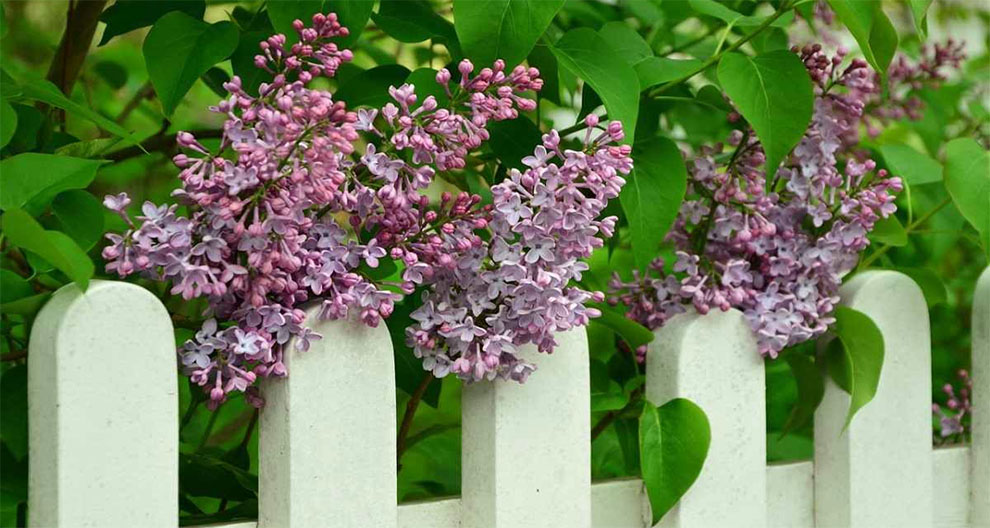Lilac Care Guide: How To Take Care Of Bushes & Trees?
The secret to thriving lilacs is plenty of sun, rich soil, moderate watering, balanced fertilizers followed by regular pruning. From planting to watering, mulching to fertilizing, this guide will empower you to create a vibrant lilac haven.

Lilacs are beautiful flowering shrub that graces landscapes and gardens with their vibrant colors and aromatic fragrance.
Amongst one of the most carefree shrubs, lilacs still need a regular care routine to ensure abundant blooming and good health.
So how to care for lilacs? It is too difficult to maintain them? Is it hard to keep them alive?
We will clear all these doubts and much more in this article.
Know that lilacs enjoy full sun, well-drained soil, regular watering, and a dose of balanced fertilizers.
Firstly, select a sunny location with well-drained soil for planting your lilacs, as they thrive in full sun. Prep the soil by adding organic matter to boost drainage and fertility.
Water your lilacs regularly, keeping the soil moist but not waterlogged. Deep watering once a week suffices, but you must alter the watering schedule per the climatic conditions.
Mulching around the shrub’s base with organic matter helps suppress weeds and retain moisture. Pruning is also a crucial step in the lilac care guide. It helps maintain shape, improve airflow, and encourage new growth, so remember to prune your lilacs after blooming.
Lilacs Care Key Takeaway
| Soil | Loamy, well-draining, neutral soil |
| Sun | Full sun |
| Temperature | Between 60°F (15°C) and 75°F (24°C) during the growing season and as low as -30°F (-34°C) in winter |
| Water | Moderate |
| Fertilizer for lilacs | A balanced fertilizer and appreciates spring feeding |
| Pruning | After flowering is over |
| Propagation | Layering, division, or cuttings |
How To Care For Lilac Bushes & Trees?
In the following section, we will take you through the care instructions for all kinds of lilac bushes and trees and offer a comprehensive guide for their optimal growth and health.
A. Spacing Lilac: How Far To Plant Lilac From The Fence

When contemplating the spacing of lilacs from the fence, it is crucial to provide ample space for the tree or shrub to flourish and grow. Plant them at least five to fifteen feet away from the fence, depending on the specific variety and its expected mature size.
This distance helps adequate air circulation and helps avoid overcrowding, which can hinder growth and become a breeding ground for diseases.
Further, providing ample space between the lilac and the fence ensures the plant gets enough sunlight for blooming and overall health.
When your lilacs have adequate room to spread, you will promote optimal growth and establish a visually pleasing landscape.
B. Is Planting Lilacs In Clay Soil A Good Idea?
Planting lilacs in clay soil can be challenging because of its poor drainage properties.
While lilacs typically cherish loamy, well-drained soil rich in organic matter, you can better clay soil and create a conducive environment for a successful lilac growth rate.
Since Lilacs cherish well-drained soil, clay soil tends to retain water, resulting in root rot. But with proper soil preparation, you can still grow lilacs in the clay soil.
Consider amending the soil with organic matter, such as aged manure or compost. It helps boost fertility and improve drainage.
Creating mounds or raised beds help accentuate drainage.
C. How Much Sun Do Lilacs Need?
A crucial step in the lilac care guide is providing the bushes and trees with adequate sunlight. Lilacs thrive in full sun. Hence, sunlight is vital for a plant’s optimal growth and blooming.
Ideally, your bushes need at least six to eight hours of direct sun daily to flourish. Adequate sunlight promotes healthy and robust growth. It also accentuates the flower’s fragrances and bestows you with abundant blooming.
Not giving lilacs ample sunlight can result in fewer blooms, weak growth, and a less robust plant overall. Hence, choose a location for planting lilacs cautiously.
It should be an area that receives ample sun across the day. By offering plant-recommended sun exposure, you can ensure your lilacs thrive and produce abundant, beautiful blooms.
D. How Much Water Do Lilacs Need?

Lilacs seek regular watering. It is necessary to maintain adequate moisture levels in the soil. But you must strike a balance and avoid overwatering, as it can result in root rot and other problems.
Ideally, water lilacs deeply once a week, ensuring the soil is soaked. During dry and hot periods, your plants might need additional watering to prevent the soil from drying out completely.
It is crucial to monitor the moisture levels in the soil and alter the watering frequency accordingly. Remember to water the plant’s base instead of the foliage to lower the disease risk.
With appropriate and consistent watering, your lilacs thrive and maintain their health.
E. How To Fertilize Lilacs?
Fertilizing lilacs is imperative to feed vital nutrients for vibrant blooms and healthy growth. The best time to fertilize the lilacs is early spring. It is when the new growth shows.
You can use a balanced, slow-release granular plant food formulated for flowering shrubs. Always follow the manufacturer’s instructions for the application rates.
Spread the plant food evenly around the lilac’s base, ensuring it does not drop on the foliage and stems. After fertilizing, water the area well to help the nutrients reach the roots.
Do not over-fertilize, as it may result in excessive foliage growth at the expense of flowers. With regular feeding once a year, you can support your lilac’s nutritional needs.
F. Lilac Bush Pruning
Often the most ignored but essential aspect in the lilac care guide is pruning. It helps maintain the plant’s health and shape and promotes abundant flowering.
Here are some tips for pruning the lilac bushes:
- Prune the lilac bushes immediately after bushes finish flowering: in late spring or early summer. It lets the plants set the buds for the subsequent year’s blooms.
- Remove the spent flowers by cutting the flower clusters slightly above the set of healthy leaves. Deadheading allows the lilacs to dedicate their energy toward new growth over seed production.
- Thin out the crowded bushes for better sunlight penetration or to boost air circulation. Remove any rubbing or crossing branches and damaged or weak ones.
- Lilacs produce suckers, and water sprouts from the plant’s interior or the base. So, promptly remove them to maintain a tidy appearance and redirect energy to the main branches.
- If your lilac bush has grown too large, selectively prune back the branches to monitor the size. You can trim the branches back to the healthy side branch or lateral bud, ensuring not to cut over 1/3rd of the total growth.
| Pro Tip – Always use sharp, clean pruning shears and tools to make clean and precise cuts and maintain the plant’s natural form and shape. Proper pruning helps keep the lilac vigorous, healthy, and blooming year after year. |
How To Take Care Of Lilacs In Winter?
Winterizing lilac bushes is crucial to guard them against harsh winter conditions to ensure their survival. Here are some vital factors to consider when winterizing lilac bushes:
1. Mulching: Apply a thick layer of organic mulch around the base before the first frost. It helps insulate the soil, retain moisture, and guard the roots against extreme temperature fluctuations.
2. Watering: Give the lilac trees deep watering before the ground freezes. It helps ensure the plant has sufficient moisture to sustain itself through the winter.
3. Avoid pruning in the fall: Pruning in the fall can stimulate new growth that may be susceptible to winter damage. Instead, wait until the lilac blooms in spring to perform any necessary pruning.
4. Cover your plants: Use protective covering or burlap for vulnerable or young lilac bushes to shield them from strong winds and heavy snow. It helps avoid branch breakage and prevent winter damage.
5. Keep the plant free from snow deposit: After heavy snow removal, brush off accumulated snow from the branches to avoid them from breaking or bending under the weight.
By taking these steps to winterize lilac bushes, you can help ensure their health and promote successful growth and blooming in the following spring.
How To Care For Old Lilac Trees?
Caring for old lilacs demand specific attention to their individual needs. Once they bloom, prune the trees to remove the diseased or dead branches and improve airflow.
Regular mulching and watering around the base helps maintain soil moisture. Fertilize in spring to offer vital nutrients. Monitor for diseases and pests and take apt measures.
Consider rejuvenation pruning for declining or overgrown trees, and remove suckers to focus energy on the main branches. Guard the trees during winter by applying mulch and wrapping them with burlap.
By employing these techniques, you can ensure your old lilac tree’s continued beauty and health, allowing them to provide fragrant blooms for many years.
What’s Killing My Lilac Bush (Pests & Diseases Protection)
Lilac bushes are susceptible to many pests and diseases that can harm their vitality and health. Here are some that affect your lilac bushes, along with the lilac care guide for protection measures:
1. Powdery mildew: This shows a powdery white coating on the stems and leaves. To guard against powdery mildew, ensure proper air circulation around the plant, consider using fungicide sprays, and avoid overhead watering.
2. Aphids: These tiny insects suck sap from the stems and leaves, causing yellowing and distortion. To keep aphids in check, spray the affected parts with insecticidal soap or use a strong jet of water to dislodge them.
You can also use natural predators like ladybugs to control aphid population.
3. Lilac Borer: Its larvae tunnel into lilac bushes, causing dieback and wilting. Preventive measures involve keeping the plants healthy, avoiding mechanical damage to the bark, and applying insecticides labeled for lilac borer control.
4. Leaf Miners: These insects create tunnels within the leaves, resulting in blister-like brown spots. Prune and destroy the affected leaves and use insecticides labeled for leaf miners.
5. Deer and rabbits: These animals browse on the lilac bushes, causing damage to the bark and foliage. Physical barriers like fences or using repellents can help guard the plants.
Regular inspection, good plant hygiene, and promptly addressing any signs of pests or diseases are essential for protecting your lilac bush.
If you’re unable to keep up with the care requirement, consult a local garden center or professional arborist to better understand how to care for lilac trees.
Related: How long do lilacs live
How To Propagate Lilacs?
You can propagate lilacs through different methods, such as cuttings, division, and layering. Here is a brief overview of multiplying the lilacs:
1. Layering: Pick a low-growing branch and make a small incision on the underside. Bury the incised portion in the shallow trench, leaving the tip exposed.
Secure it in place with a store or wire. Over time, roots will develop. Once rooted, cut the new plant from the parent plant to transplant it.
2. Division: Dig up any established, healthy lilac bush during the dormant season. Divide the root ball into smaller sections, ensuring every division has healthy shoots and roots. Replant the divisions in prepared soil and water well.
Here is the guide for you to learn how to split lilac bushes.
3. Cuttings: Take semi-hardwood cuttings in early summer. Select healthy, non-flowering shoots and trim them to about six inches in length. Remove the lower leaves and dip the cut end in the rooting hormone.
Plant the cutting in a pot filled with well-draining soil. Keep it moist. Place the pot in a bright, warm area away from direct sunlight. After the cuttings develop roots, you can transplant them in their permanent location.
With these propagation techniques, you can expand your lilac collection and share its beauty with others.
